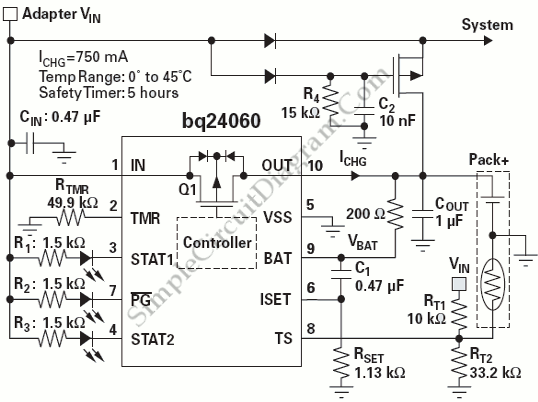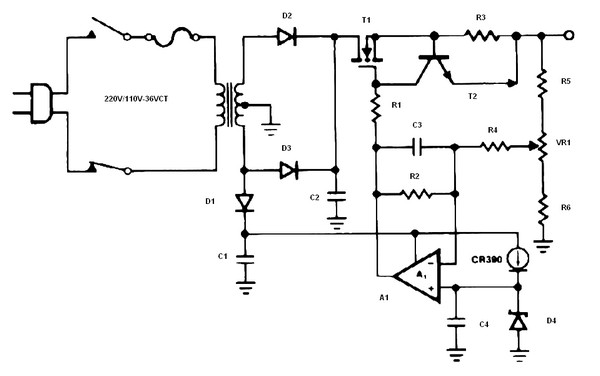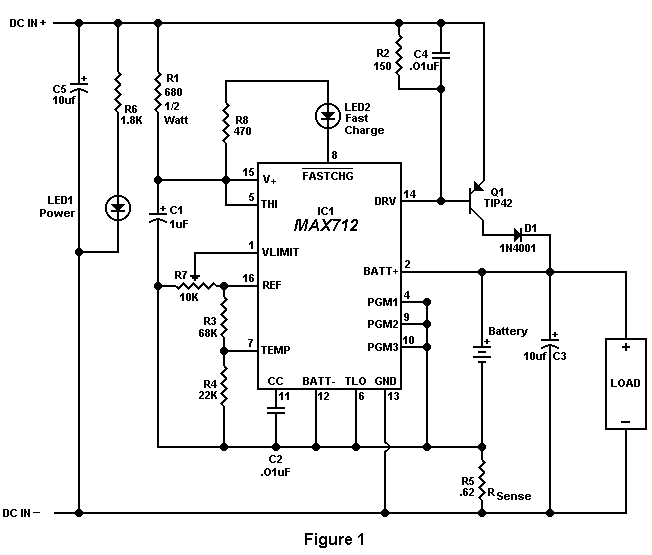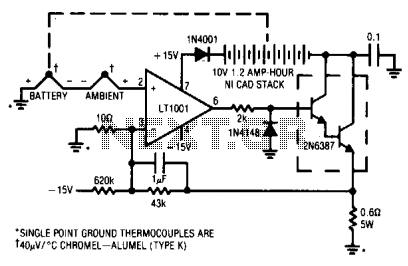
Car-Battery charger for Nokia 8210

It's just a simple power supply with a 7805 regulator. The chip must be mounted on a large metal radiator because the current requested by the regulator is near 0.4 A. However, to lower the power, you can put a 10 ohm 2 watt (0.4*5=2 w) in series to the input pin. You can use it in your car by connecting it to your lighter plug.
This circuit employs a 7805 voltage regulator, which is a linear voltage regulator that outputs a steady 5V from a higher input voltage, typically in the range of 7V to 35V. The 7805 is designed to provide a maximum output current of 1A, but in this application, it is limited to 0.4A, which necessitates the use of a heatsink to dissipate excess heat generated during operation. The heatsink is critical for maintaining the thermal stability of the regulator and preventing thermal shutdown.
To further manage power consumption, a 10-ohm, 2-watt resistor is introduced in series with the input pin of the 7805. This resistor serves to limit the input current and, consequently, the power output. The calculation provided indicates that with a current of 0.4A and an output voltage of 5V, the power dissipation across the resistor can be calculated as follows: P = I²R, which results in 0.4² * 10 = 1.6W, ensuring that the resistor is rated appropriately for this application.
The power supply can be conveniently powered through a car's lighter plug, making it suitable for mobile use. The circuit should include appropriate fuses or circuit protection to prevent damage from overcurrent conditions. Additionally, proper decoupling capacitors should be placed at the input and output of the 7805 to ensure stable operation and filter out any noise from the power supply.
Overall, this power supply design is straightforward and effective for providing a regulated 5V output suitable for powering devices like the Nokia 8210, ensuring compatibility with automotive applications while maintaining reliability and safety.It`s just a simple power supply with a 7805 regulator, the chip must be mounted on a large metal radiator, because the current requested by the regulator is near 0.4 A However to lower the power, you can put a 10 ohm 2 watt( 0.4*5=2 w) in series to input pin. You can use it in you car , by connecting it to your lighter plug. A simple and functional project for your Nokia 8210. The charging time is equal to that of t 🔗 External reference
This circuit employs a 7805 voltage regulator, which is a linear voltage regulator that outputs a steady 5V from a higher input voltage, typically in the range of 7V to 35V. The 7805 is designed to provide a maximum output current of 1A, but in this application, it is limited to 0.4A, which necessitates the use of a heatsink to dissipate excess heat generated during operation. The heatsink is critical for maintaining the thermal stability of the regulator and preventing thermal shutdown.
To further manage power consumption, a 10-ohm, 2-watt resistor is introduced in series with the input pin of the 7805. This resistor serves to limit the input current and, consequently, the power output. The calculation provided indicates that with a current of 0.4A and an output voltage of 5V, the power dissipation across the resistor can be calculated as follows: P = I²R, which results in 0.4² * 10 = 1.6W, ensuring that the resistor is rated appropriately for this application.
The power supply can be conveniently powered through a car's lighter plug, making it suitable for mobile use. The circuit should include appropriate fuses or circuit protection to prevent damage from overcurrent conditions. Additionally, proper decoupling capacitors should be placed at the input and output of the 7805 to ensure stable operation and filter out any noise from the power supply.
Overall, this power supply design is straightforward and effective for providing a regulated 5V output suitable for powering devices like the Nokia 8210, ensuring compatibility with automotive applications while maintaining reliability and safety.It`s just a simple power supply with a 7805 regulator, the chip must be mounted on a large metal radiator, because the current requested by the regulator is near 0.4 A However to lower the power, you can put a 10 ohm 2 watt( 0.4*5=2 w) in series to input pin. You can use it in you car , by connecting it to your lighter plug. A simple and functional project for your Nokia 8210. The charging time is equal to that of t 🔗 External reference





